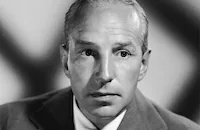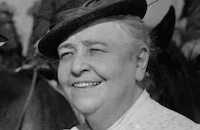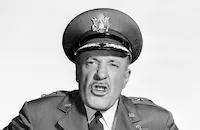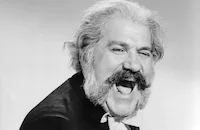The Lemon Drop Kid

Brief Synopsis
Cast & Crew
Sidney Lanfield
Bob Hope
Marilyn Maxwell
Lloyd Nolan
Jane Darwell
Andrea King
Film Details
Technical Specs

Synopsis
Just before a horserace at a Florida track, notorious tout Sidney Milburn, known as The Lemon Drop Kid because of his fondness for lemon candies, talks an attractive stranger into changing her bet, unaware that she is placing the wager for her boyfriend, gangster Moose Moran. After Moose's original pick wins and Moose discovers that The Kid has caused him to lose $2,000 instead of winning $10,000, he orders his goons to drag The Kid to his home. There, Moose threatens The Kid with torture, but The Kid insists that he can deliver $10,000 to Moose at his defunct Long Island casino by Christmas. With twenty-three days to go, The Kid returns to his hometown, New York City, wearing only a summer suit. While trudging through a blizzard, the freezing Kid runs into Nellie Thursday, an old friend, who laments that her safecracker husband, Henry Regan, is being released from prison on Christmas Eve and she is about to be evicted. The Kid sympathizes, but as he is broke and needs ten dollars to get his winter clothes out of hock, admits he cannot help her. The Kid then drops in on his sometime girl friend, singer Brainey Baxter, and persuades her to give him ten dollars by vowing to marry her right after he reclaims his clothes. Later, The Kid visits gangster Oxford Charlie, the owner of the nightclub at which Brainey works, and asks for a $10,000 loan. After Charlie laughingly sends him on his way, The Kid notices a sidewalk Santa Claus collecting donations and gets an idea. Dressed in his own Santa Claus suit, The Kid starts soliciting from passersby but is recognized by a policeman and arrested. While in jail, The Kid is visited by Moose's enforcer, Sam the Surgeon, who reminds him about his upcoming payment deadline. Suddenly inspired, The Kid assures Sam he has a brilliant idea for raising the money: He will temporarily turn Moose's empty casino into a retirement home for old women, obtain a state charity license, and use sidewalk Santas to collect "donations." As hoped, Brainey then bails The Kid out, intending to force him into an immediate marriage. The Kid, however, persuades her to wait and solicits help from various unsuspecting friends, telling them that they will be raising money for a home for Nellie, who has just been arrested. After bailing Nellie out, The Kid and his cohorts escort her to the casino, which has just been renamed the Nellie Thursday Home for Old Dolls. Soon, the craps tables, which can be hidden in the walls in case of police raids, are converted into beds, and the place is bustling with elderly women. With only two weeks until Christmas, The Kid and his friends then begin their fund-raising campaign on the streets of New York. When Brainey, who is still unaware of The Kid's scheme, tells Charlie about the Santa fund-raising operation, Charlie decides to "muscle in" on The Kid's activities. While The Kid and his friends are busy soliciting donations, Charlie and his goons kidnap the old women and steal the $16,000 The Kid has collected. Finding the casino deserted, The Kid deduces Charlie's subterfuge and, with Brainey and his friends, races to the gangster's New Jersey home, where Nellie and the other women are being held. The Kid denounces Charlie, but Charlie calls Moose, who proves to The Kid's disbelieving friends that The Kid was raising the money for his own use. Brainey is furious at The Kid and unmoved by his predicament. Later, on Christmas Eve, The Kid sees Nellie, who managed to escape from Charlie's, and convinces her to round up the gang and bring them to New Jersey. The Kid then steals some women's clothes and shows up at Charlie's, posing as an old lady. After gaining access to Charlie's office, The Kid reveals himself to his rival, knocks him out and steals his money bag. Fleeing on a borrowed bicycle, The Kid races to the city, eventually ending up at Moose's casino. When the waiting Moose demands all of The Kid's money, the walls open up to reveal Nellie and the gang gambling at the craps tables. Just as The Kid announces that he has called the police, the place is raided and Charlie and his goons are arrested. Before he can escape, The Kid is cornered by a judge, who demands that The Kid use the money to run an honest retirement home. Later, Nellie's just-released husband appears at the reinstated home, and while he and Nellie enjoy their long-awaited reunion, The Kid proposes to a forgiving Brainey.

Director
Sidney Lanfield
Cast

Bob Hope

Marilyn Maxwell

Lloyd Nolan

Jane Darwell

Andrea King

Fred Clark

Jay C. Flippen

William Frawley

Harry Bellaver

Sid Melton
Ben Welden
Ida Moore
Francis Pierlot
Charles Cooley
Society Kid Hogan
Harry Shannon
Bernard Szold
Tor Johnson
Tom Dugan
Patsy Moran
Hallene Hill
Sarah Edwards
Bee Humphries
Patsy O'byrne
Kate Mackenna
Hazel Boyne
Almira Sessions
Fred Zendar
Slim Gaut
Joan Whitney
Tommy Ivo
Joe Recht
Helen Brown
Bill Cartledge
Wade Crosby
Eric Alden

Ralph Dunn
Fred Graff
Sid Tomack
Jim Hayward
Jimmie Dundee
John Indrisano
Jack Shea
Mike Ross
Jack Stoney

Roy Gordon
Stanley Andrews
Bob Foulk

Jack Kruschen

John Doucette

Douglas Spencer
Harry O. Tyler
Jerry James
Bill Sheehan
Ray Cook
Walter Russell
Joey Ray
Roger Creed
Ralph Volkie
John Grant
Pat Moran
Don Dunning
Sue Carleton
Vivian Mason
Patricia Wright
Charmienne Harker
Rosalie Calvert
Geraldine Knapp
Lorraine Crawford
Diana Mumby
Barbara Freking
Lola Kendricks
Nolan Leary
Bruce Riley
Benny Burt
Mike Mahoney
Guy Zanette
Ralph Montgomery
Al Ferguson
John "skins" Miller
Gil Warren
Eugene O. Roth
Richard Karlan
Bill Varga
Jim Davies
Mike Pat Donovan
Sandy Peck
Jerry Mullins

Mary Murphy
Paul "tiny" Newlan
Robert S. O'connor
Richard Barron
Pat Flaherty
Anna Chandler
Billie Bird
Oliver Blake
John Brown
Henry Hope
Jack Roberts
Allen Mathews
Isabel Cushin
Crew
Franz Bachelin
Claire Behnke
Edmund Beloin
Charles Berner
Frank Caffey
Sam Comer
Ross Dowd
Farciot Edouart
Irving Elinson
Ray Evans
Daniel L. Fapp
Edmund Hartmann
Edith Head
Len Hendry
Society Kid Hogan
Richard L. Johnston
Ted Larsen
Paul Lerpae
Sam Levine
Joseph J. Lilley
Jay Livingston
Salvatore De Lorenzo
Archie Marshek
Don Mckay
Robert O'brien
Walter Oberst
Hal Pereira
Gertrude Reade
Edward Salven
Troy Sanders
William Sosteleo
Ruth Stella
Frank Tashlin
Lenore Weaver
Robert L. Welch
Wally Westmore
Victor Young

Videos
Movie Clip



Film Details
Technical Specs

Articles
The Lemon Drop Kid
"Silver Bells" (wisely renamed after Livingston's wife pointed out that "tinkle" was kiddie slang for "urinate") is unique among Christmas songs in that, instead of the nostalgic rural setting described in "Jingle Bells" or "O Christmas Tree", it's set in a modern, urban milieu of "busy sidewalks" and "strings of street lights". It's a perfect fit for the tough yet sentimental The Lemon Drop Kid (1951), a holiday movie based on a story by literary tough guy Damon Runyon.
Runyon, a newspaper man whose stock in trade was gritty chronicles of Prohibition-era New York, had his work adapted previously for the screen in Little Miss Marker (1934) and its remake Sorrowful Jones (1949). Bob Hope had earned critical applause for his role in that remake, and he was ready to try a Runyon story again, with the same director Sidney Lanfield, this time playing a glib con man who conjures up a comical scheme involving street-corner Santas as a way to pay off a scorned gangster.
As usual, Hope took an active role in production, insisting on casting unknown Marilyn Maxwell as the female lead because he liked her comic timing and screen sex appeal. "I worked with her in New York," Hope told studio brass. "She's good. I want her and that's enough for me." (It also helped that he and Maxwell were having a clandestine affair, a personal and work partnership that lasted through many movies, tours, and TV specials.) He also complained to studio president Barney Balaban that Lanfield's cut of the finished film was lacking. Not only did Hope feel he'd been slighted on screen time, but Lanfield missed the sentimental angle that was crucial to Sorrowful Jones' success.
One particular sticking point was the "Silver Bells" number. In the original staging, Lanfield simply stood all the cast members shoulder to shoulder in the shady interior of a vacant casino, in what Hope biographer Lawrence J. Quirk described as "in the manner of a Hollywood choir." Hope knew the "Silver Bells" number had the makings of a showstopper. He'd previously done well with "Buttons and Bows", another Livingston/Evans tune performed by Hope in The Paleface (1948). (That song earned the songwriting duo the first of three Academy Awards). Besides, his "road movie" pal Bing Crosby had just recorded a version of the song with Carol Richards. Hope, not to be upstaged, recruited joke writer Frank Tashlin to rewrite the scene. Tashlin drove a hard bargain. He'd labored in Hollywood for years as a gagman and was hungry to direct his own movies. He wanted to direct the scene, and Hope agreed. (Lanfield was so incensed to learn that Hope had ousted him that he never worked with the comedian again.)
Tashlin's revision wisely moved the scene to a busy shopping thoroughfare in the city, using the song to link vignettes of urban good cheer. Hope, dressed in a ragged Santa costume, strolls arm-in-arm with Maxwell through the lightly falling snow as kids eye toys in store windows, peddlers sell chestnuts and mistletoe, and shoppers smile at all the holiday decorations. The number ends on a wide shot of a snow-kissed metropolis, the light in every skyscraper window twinkling like a star.
Tashlin went on to direct Technicolor comedies like The Girl Can't Help It (1956) and Will Success Spoil Rock Hunter? (1957), while Livingston and Evans were forever grateful for the royalties earned by their now-classic Christmas song, a perennial tune that's sold over 500 million records and been covered by everyone from Stevie Wonder to the Chipmunks to Twisted Sister. But while audiences enjoyed a cozy Christmas in theaters, the perennially restless Hope was already on the road. The first day of shooting for The Lemon Drop Kid was also the first day of the conflict that became The Korean War. In between squabbles, rewrites, and reshoots, Hope was also busy organizing the biggest USO show to date - 50 entertainers, including a radio crew and every member of the Les Brown big band - for troops in the Pacific, a Christmas tradition that would continue until 1995, when Hope retired from military touring at the age of 92.
Producer: Robert L. Welch
Director: Sidney Lanfield; Frank Tashlin (uncredited)
Screenplay: Edmund Beloin, Damon Runyon (story); Irving Elinson (additional dialogue); Edmund L. Hartmann, Robert O'Brien, Frank Tashlin
Cinematography: Daniel L. Fapp
Art Direction: Franz Bachelin, Hal Pereira
Music: Victor Young
Film Editing: Archie Marshek
Cast: Bob Hope (Sidney Melbourne - The Lemon Drop Kid), Marilyn Maxwell ('Brainy' Baxter), Lloyd Nolan (Oxford Charley), Jane Darwell (Nellie Thursday), Andrea King (Stella), Fred Clark (Moose Moran), Jay C. Flippen (Straight Flush), William Frawley (Gloomy Willie), Harry Bellaver (Sam the Surgeon), Sid Melton (Little Louie).
BW-91m.
by Violet LeVoit
Resources:
"What's In A Song? Silver Bells" NPR, Dec 25 2005
Quirk, Lawrence J. Bob Hope: the road well traveled. Thorndike Press, 2001
Strait, Raymond. Bob Hope: A Tribute. Pinnacle, 2002
Faith, William Robert. Bob Hope: A Life in Comedy. Da Capo, 2003

The Lemon Drop Kid
TCM Remembers - Jack Kruschen
Jack Kruschen (1922-2002)
He may have not been a household name, yet his career consisted of over seventy-five films, spanned over six decades, and displayed a strong versatility in playing either dramatic or comic roles with equal effectiveness. He was the definitive, "I can't quite remember the name, but I remember the face" character player who enlivened many films with his robust frame, cherubic face and infectious smile. His name was Jack Kruschen, a superb performer who died on April 2, 2002 at the age of 80, leaving behind a strong body of work that was impressive as any character actor of his generation.
Kruschen was born on March 20, 1922 in Winnipeg, Manitoba, Canada. The son of a watchmaker who later set up shop in Hollywood, he was performing in an operetta at Hollywood high school when a talent scout for CBS radio discovered him. Kruschen was soon doing voice characterizations on popular network programs such as Dragnet, The Danny Thomas Show and Sam Spade. With his gift for dialects (he was most adept at playing ethnic types like Greeks, Yiddish or Italians - a skill finely honed in his radio days), Kruschen was a natural for the movies and soon made his film debut with a small role in the Betty Hutton comedy Red, Hot and Blue (1949).
Kruschen's early career is peppered with a variety of roles like a comical gangster in both Abbott & Costello Go to Mars (1953) and Money from Home (1953) starring Jerry Lewis & Dean Martin; a hard-nosed police detective in Confidence Girl (1952) and Julie (1956), an underrated Doris Day thriller; or doomed victims to alien prey in Sci-fi cult classics: the 1953 version of War of the Worlds (fans remember him as Salvatore, one of the first earthlings to be killed by the invading Martians) and The Angry Red Planet (1959). The roles offered steady work, but not much critical recognition. All that changed when Billy Wilder cast him in the key role as Jack Lemmon's bemused but caring neighbor, Dr. Dreyfuss in The Apartment (1960). As the man who observes the steady stream of women in and out of Lemmon's apartment and the one who saves Shirley MacLaine from a drug overdose, Kruschen offered a wonderful performance - viewing his neighbor's proceedings with a jaundiced eye, yet never letting his disdain overtake his humor and humanity. He was justly rewarded with an Oscar nomination as Best Supporting Actor.
From this point on, Kruschen was seldom out of work, appearing in over 40 films (including a terrific dramatic turn in the original Cape Fear (1962) as Dave Grafton, a corrupt southern bigot) and nearly 60 guest roles on television for the next two decades. Kruschen would later find fame toward the end of his career when he was cast as Papa Papadapolis in the hit sitcom Webster (1985-1987) and would show pleasant variations of the "kindly old codger" throughout the remainder of his career - like his final role in the romantic comedy 'Til There Was You (1997). His death in April this year may have gone largely unnoticed by the movie-going public, but for those of us who treasure the art of the character player, Kruschen's passing was a loss that is fortunately compensated by his strong body of work that will be enjoyed for fans of the late show for many years to come.
By Michael T. Toole
SIGNE HASSO, 1910-2002
Actress Signe Hasso died June 7th at the age of 91. She was best-known for starring in A Double Life (1947) but played numerous Europeans in films during the 1940s. Hasso was born on August 15, 1910 in Stockholm, Sweden and began acting on stage at the age of 13. Ten years later made her first film appearance as Signe Larsson. She was married in 1936 and adopted the last name of her husband, cinematographer and later director Harry Hasso. After a dozen Swedish films, Hasso moved to Hollywood in 1940 where her first screen appearance was an uncredited role in Journey for Margaret (1942). A brief stint at RKO didn't lead to any more promising film parts so Hasso concentrated on her stage career in New York City. Eventually, her film career became more active, thanks to a quick succession of roles, most notably in Fred Zinnemann's The Seventh Cross (1944), Douglas Sirk's A Scandal in Paris (1946) and Henry Hathaway's The House on 92nd Street (1945). However it was her portrayal of Ronald Colman's wife in the Oscar-favorite A Double Life that solidified her fame. But as Hasso continued to act on the stage and TV, her film work began to taper off. She appeared in high-profile thrillers like Crisis (1950), several made-for-TV movies, a few European productions and even the cult murder mystery, Bert Gordon's Picture Mommy Dead (1966). In 1972, the king of Sweden decorated Hasso for her work. Her final appearance was in a 2001 documentary about Greta Garbo.
HERMAN COHEN, 1927-2002
One of the key producers of B-movies, Herman Cohen, died June 2nd at the age of 76. Like most producers, his name wasn't generally known outside the industry or the realms of film buffs but most people never forget the titles of his films: I Was a Teenage Werewolf (1957), Horrors of the Black Museum (1959) and the not-quite-immortal Bela Lugosi Meets a Brooklyn Gorilla (1952). Cohen was a Detroit native, born August 27, 1927. He entered the film business in the smallest possible way, as a 12-year-old janitor, often accepting passes for his family and friends instead of wages. Cohen served in the Marine Corps (several articles incorrectly say the Army) before becoming a publicist at Columbia Pictures. By 1951 he was working as a producer's assistant on low-budget independent films, mostly for Realart Pictures run by another Detroit native Jack Broder. Soon Cohen was producing his own movies, including Westerns and mysteries, until hitting big with the famous I Was a Teenage Werewolf. Starring a then-unknown Michael Landon (under personal contract to Cohen who later tore it up so Landon could appear in Bonanza), the film was made for $100,000 but in just a few months grossed over $2 million. Cohen didn't hestitate to turn out I Was a Teenage Frankenstein and Blood of Dracula by Thanksgiving of that same year and before long had made several films that continued to earn money for years to come. (One TCM writer remembers Horrors of the Black Museum turning up in a small Alabama town in the early 70s, over a decade after its initial release. The film is scheduled for a DVD release with a Cohen commentary from VCI Entertainment.) Cohen also made several films in England including The Headless Ghost (1959) and the cult favorite Konga (1961) where Cohen even paid RKO $25,000 for the rights to use the title King Kong in publicity for his own film. Cohen's later movies included a spaghetti Western and Joan Crawford's final acting role Trog (1970). In the 1980s Cohen ran a company, Cobra Media, that distributed some films and licensed material such as Teenage Werewolf to Landon for use in one of his Highway to Heaven episodes.
By Lang Thompson
TCM Remembers - Jack Kruschen
Quotes
Santy Claus don't drink.- Sidney Melbourne, the Lemon Drop Kid
Oh, no? Well, how come he's always falling down chimleys?- Gloomy Willie
Trivia
Frank Tashlin (uncredited) directed about one third of the entire film.
Notes
The film's title card reads: "Damon Runyon's The Lemon Drop Kid." Runyon's original short story was later published in his collection Blue Plate Special (New York, 1934). The order of the opening cast credits differs from the end credits, and some names appear only in the end credits. The story opens with the following written statement: "This is a race track in Florida. Damon Runyon frequented such race tracks, for it was there that he met many of the people he wrote about...horse owners, trainers, jockeys, grooms, gamblers, pickpockets....There are many sources from which those who bet receive their information about the horses. Damon Runyon wrote about an interesting source of mis-information called 'The Lemon Drop Kid.'"
Ray Livingston and Jay Evans' song "Silver Bells" was first performed in The Lemon Drop Kid and quickly became a Christmas standard. Bing Crosby, Bob Hope's frequent co-star, made the first recording of the song. Hollywood Reporter news items list the following actors in the cast: Al Klein, James Cornell, Margaret Zane, Janet King, Noreen Lee, George Barrows, Chuck Hamilton, George Magrill, Marie Thomas, Susanne Rosser, Franklyn Farnum, Marie Reeves, Margaret Roberts, Jack Ellis, Rex Foster, Kenneth Kendall, Thelma Woodruff, Paul Lacy, Rex Moore, Norma Fenton, Shirley Anderson, Dick Cherney, Richard Clark, Marilyn Caplan, Brick Sullivan, Harry Wilson, Mae George, Stephen Gordon, Michael Cowan, Virginia Olson, Martin Lessow, Ann Beck, Peggy Dale, Barbara Painter, Mildred Baer, Charles Millsfield, Freeman High, Mary Moder, John Ardizoni, Marian Mosick, Lynnette Bryant, Charles Booker, Helen St. Rayner, Linda Garrison, Joy McDade, Jim Pierce, Evelyn Cedar, Wally Boyle, Jerry Housner, Lyle Moraine, Joan Arnold and Lee Winter. The appearance of these actors in the completed film has not been confirmed. Studio publicity materials include vaudevillians The Cirillo Brothers in the cast, but their appearance in the final film also has not been confirmed.
The Lemon Drop Kid marked Hope's second appearance in a Runyon story. In 1949, he made the highly successful Paramount release Sorrowful Jones, which was based on Runyon's short story "Little Miss Marker" (see AFI Catalog of Feature Films, 1941-50). Screenwriter Edmund Hartmann worked on both pictures, and both films were produced by Robert L. Welch and directed by Sidney Lanfield. According to modern sources, Hope wanted January Sterling as his co-star, but because of delays due to script problems, she could not participate. Principal photography ended in mid-August 1950, but as noted in Hollywood Reporter news items, the film went back into production in mid-November 1950. Modern sources state that after viewing a rough cut of the picture, Hope asked Paramount to hire Frank Tashlin to do some rewrites and that Tashlin agreed on condition that he could also direct the retakes. According to modern sources, Tashlin rewrote and directed the elaborate "Silver Bells" sequence. Charley Cooley, who plays "Goomba" in the film, was Hope's former vaudeville partner and boyhood friend. According to studio publicity, the Florida horseracing scene was shot at the Santa Anita Racetrack in Arcadia, CA.
Hope and Marilyn Maxwell reprised their roles for a December 10, 1951 Lux Radio Theatre broadcast. In 1934, Paramount had released a film called The Lemon Drop Kid, directed by Marshall Neilan and starred Lee Tracy (see AFI Catalog of Feature Films, 1931-40), which was also based on the Runyon short story. The plot of the earlier picture has few similarities to the 1951 picture, and although neither film is completely faithful to Runyon's original story, the 1934 version more closely resembles it. William Frawley, who portrayed "Gloomy Miller" in the 1951 picture, also appeared in the 1934 film, as The Kid's sidekick "The Professor."

Miscellaneous Notes
Released in United States 1951
Released in United States 1951













